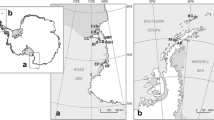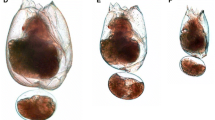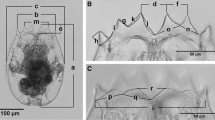Abstract
Cryptic species are continuously discovered in rotifers using different methods to delineate these units of diversity. DNA taxonomy is the most effective method taxonomists have to untie potential cryptic taxa. Here, we estimate hidden diversity in a genus of bdelloid rotifers, Adineta. We analyse cryptic diversity using a coalescent approach to infer evolutionarily significant units from a phylogenetic tree obtained from cytochrome oxidase I sequences. Cryptic diversity was measured for eight traditional species and from several additional undetermined populations. Taxonomic inflation of up to 36 taxa was found in A. vaga from DNA taxonomy. As observed in other microscopic organisms, cryptic taxa within each traditional species were not geographically isolated, but had significantly narrower ecological niches than expected by chance alone.

Similar content being viewed by others
References
Barraclough, T. G., C. W. Birky & A. Burt, 2003. Diversification in sexual and asexual organisms. Evolution 57: 2166–2172.
Bohonak, A. J. & D. G. Jenkins, 2003. Ecological and evolutionary significance of dispersal by freshwater invertebrates. Ecology Letters 6: 783–796.
Donner, J., 1965. Ordnung Bdelloidea. Bestimmungsbücher zur Bodenfauna Europas 6. Akademie Verlag, Berlin.
Felsenstein, J., 1981. Skepticism towards Santa Rosalia, or why are there so few kinds of animals? Evolution 35: 124–138.
Fenchel, T. & B. J. Finlay, 2004. The ubiquity of small species: patterns of local and global diversity. BioScience 54: 777–784.
Fontaneto, D., G. F. Ficetola, R. Ambrosini & C. Ricci, 2006. Patterns of diversity in microscopic animals: are they comparable to those in protists or in larger animals? Global Ecology and Biogeography 15: 153–162.
Fontaneto, D., T. G. Barraclough, K. Chen, C. Ricci & E. A. Herniou, 2008. Molecular evidence for broad-scale distributions in bdelloid rotifers: everything is not everywhere but most things are very widespread. Molecular Ecology 17: 3136–3146.
Fontaneto, D., M. Kaya, E. A. Herniou & T. G. Barraclough, 2009. Extreme levels of hidden diversity in microscopic animals (Rotifera) revealed by DNA taxonomy. Molecular Phylogenetics and Evolution 53: 182–189.
Gilbert, J. J. & E. J. Walsh, 2005. Brachionus calyciflorus is a species complex: mating behavior and genetic differentiation among four geographically isolated strains. Hydrobiologia 546: 257–265.
Gómez, A., M. Serra, G. R. Carvalho & D. H. Lunt, 2002. Speciation in ancient cryptic species complexes: evidence from the molecular phylogeny of Brachionus plicatilis (Rotifera). Evolution 56: 1431–1444.
Jenkins, D. G. & M. O. Underwood, 1998. Zooplankton may not disperse readily in wind, rain, or waterfowl. Hydrobiologia 388: 15–21.
Kaya, M., E. A. Herniou, T. G. Barraclough & D. Fontaneto, 2009. Inconsistent estimates of diversity between traditional and DNA taxonomy in bdelloid rotifers. Organisms Diversity and Evolution 9: 3–12.
Keane, T. M., C. J. Creevey, M. M. Pentony, T. J. Naughton & J. O. McInerney, 2006. Assessment of methods for amino acid matrix selection and their use on empirical data shows that ad hoc assumptions for choice of matrix are not justified. BMC Evolutionary Biology 6: 29.
Monaghan, M. T., R. Wild, M. Elliot, T. Fujisawa, M. Balke, D. J. G. Inward, D. C. Lees, R. Ranaivosolo, P. Eggleton, T. G. Barraclough & A. P. Vogler, 2009. Accelerated species inventory on Madagascar using coalescent-based models of species delineation. Systematic Biology 58: 298–311.
Pons, J., T. G. Barraclough, J. Gomez-Zurita, A. Cardoso, D. P. Duran, S. Hazell, S. Kamoun, W. D. Sumlin & A. P. Vogler, 2006. Sequence based species delimitation for the DNA taxonomy of undescribed insects. Systematic Biology 55: 595–609.
R Development Core Team, 2008. R: a language and environment for statistical computing. R Foundation for Statistical Computing, Vienna, Austria [available on internet at http://www.R-project.org].
Ricci, C., 2001. A reconsideration of the taxonomic status of Macrotrachela quadricornifera (Rotifera, Bdelloidea). Journal of Zoology 255: 273–277.
Ricci, C., M. Caprioli & D. Fontaneto, 2007. Stress and fitness in parthenogens: is dormancy a key feature for bdelloid rotifers? BMC Evolutionary Biology 7(Suppl 2): S9.
Ronquist, F. & J. P. Huelsenbeck, 2003. MrBayes 3: Bayesian phylogenetic inference under mixed models. Bioinformatics 19: 1572–1574.
Sanderson, M. J., 2002. Estimating absolute rates of molecular evolution and divergence times: a penalized likelihood approach. Molecular Biology and Evolution 19: 101–109.
Schroder, T. & E. J. Walsh, 2007. Cryptic speciation in the cosmopolitan Epiphanes senta complex (Monogononta, Rotifera) with the description of new species. Hydrobiologia 593: 129–140.
Segers, H., 2007. Annotated checklist of the rotifers (Phylum Rotifera), with notes on nomenclature, taxonomy and distribution. Zootaxa 1564: 3–104.
Smith, M. A., J. J. Rodriguez, J. B. Whitfield, A. R. Deans, D. H. Janzen, W. Hallwachs & P. D. N. Hebert, 2008. Extreme diversity of tropical parasitoid wasps exposed by iterative integration of natural history, DNA barcoding, morphology, and collections. Proceedings of the National Academy of Sciences of the United States of America 105: 12359–12364.
Suatoni, E., S. Vicario, S. Rice, T. Snell & A. Caccone, 2006. An analysis of species boundaries and biogeographic patterns in a cryptic species complex: the rotifer Brachionus plicatilis. Molecular Phylogenetics and Evolution 41: 86–98.
Acknowledgments
Samples and sequences from Sweden were obtained thanks to a grant to DF from the Swedish Taxonomy Initiative; the ones from the Balkans were obtained thanks to an INTAS Fellowship for young scientists to NI, Ref. No 06-1000014-5639. Thanks to Frederik Leliaert and an anonymous referee for improving the original version of the manuscript.
Author information
Authors and Affiliations
Corresponding author
Additional information
Guest editors: N. Walz, R. Adrian, J.J. Gilbert, M.T. Monaghan, G. Weithoff & H. Zimmermann-Timm / Rotifera XII: New aspects in rotifer evolution, genetics, reproduction, ecology and biogeography
Rights and permissions
About this article
Cite this article
Fontaneto, D., Iakovenko, N., Eyres, I. et al. Cryptic diversity in the genus Adineta Hudson & Gosse, 1886 (Rotifera: Bdelloidea: Adinetidae): a DNA taxonomy approach. Hydrobiologia 662, 27–33 (2011). https://doi.org/10.1007/s10750-010-0481-7
Published:
Issue Date:
DOI: https://doi.org/10.1007/s10750-010-0481-7




